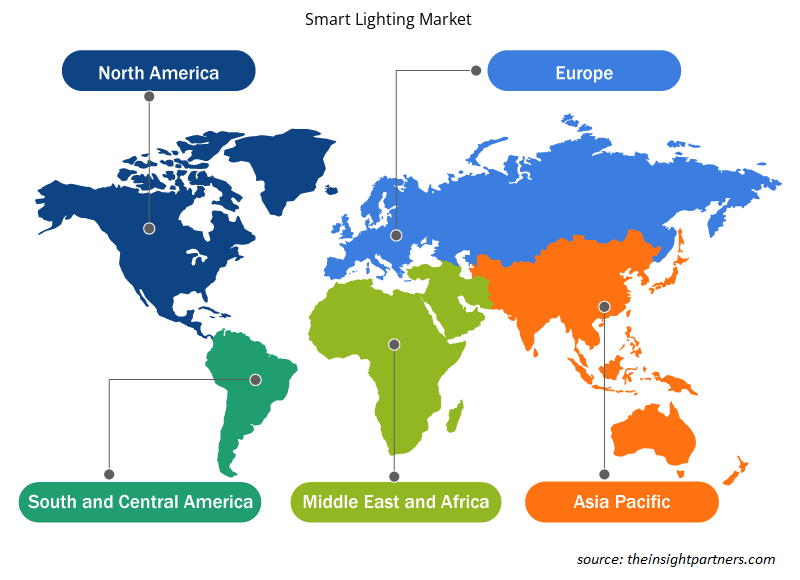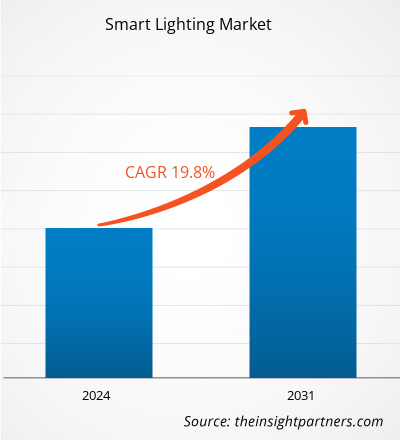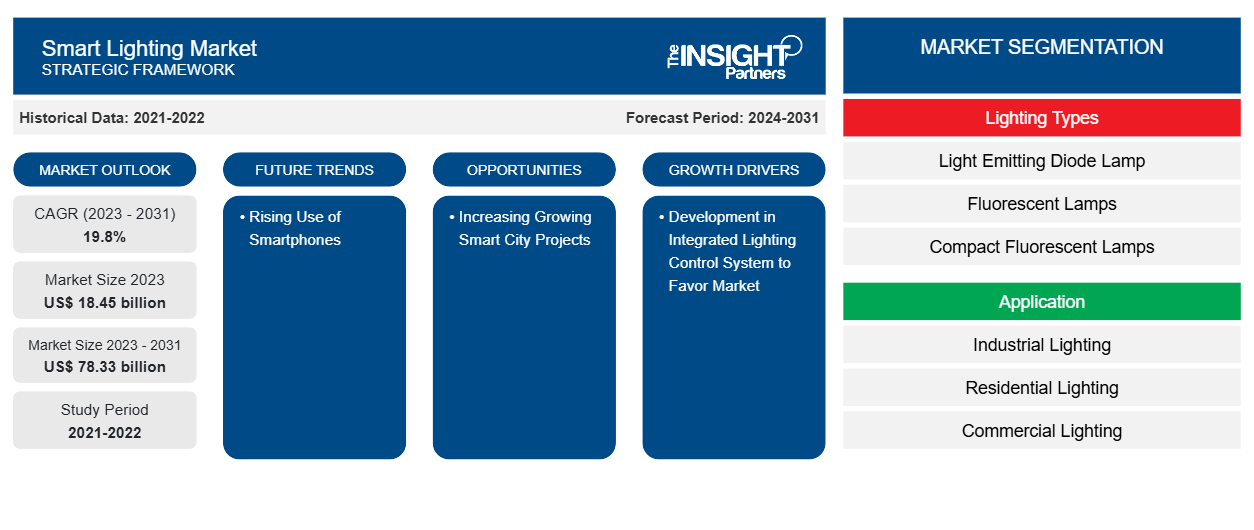من المتوقع أن يصل حجم سوق الإضاءة الذكية إلى 78.33 مليار دولار أمريكي بحلول عام 2031 من 18.45 مليار دولار أمريكي في عام 2023. ومن المتوقع أن يسجل السوق معدل نمو سنوي مركب بنسبة 19.8٪ في الفترة من 2023 إلى 2031. ومن المرجح أن يظل تطوير أنظمة التحكم في الإضاءة المتكاملة ومشاريع المدن الذكية المتنامية من أهم اتجاهات سوق الإضاءة الذكية.
تحليل سوق الإضاءة الذكية
يشهد سوق الإضاءة الذكية نموًا سريعًا. وفي السنوات الأخيرة، شهد سوق الإضاءة الذكية نموًا كبيرًا بسبب مشاريع المدن الذكية الجارية والمقبلة في الاقتصادات النامية.
نظرة عامة على سوق الإضاءة الذكية
أصبحت الأضواء أكثر شعبية وطلبًا في كل من البيئات التجارية والسكنية نظرًا لقدرتها على الارتباط بأجهزة إنترنت الأشياء وإنتاج مجموعة من الإضاءة المحيطة باستخدام الهواتف الذكية أو الأجهزة اللوحية البسيطة. حسب الحاجة، يمكن تعتيم الأضواء الذكية إلى مجموعة متنوعة من درجات الألوان. ويمكن أيضًا توصيلها عبر Wi-Fi أو Bluetooth أو SmartThings أو Z-Wave أو ZigBee، ويمكن برمجتها لتشغيلها أو إيقاف تشغيلها. علاوة على ذلك، يمكن تحقيق التحكم الصوتي في الأضواء الذكية من خلال تكامل المنصة، مثل Google Assistant وMicrosoft Cortana وApple Siri وAmazon Alexa. بالإضافة إلى الإضاءة، تتضمن مجموعات الميزات الشاملة هذه أيضًا عددًا متزايدًا من أجهزة إنترنت الأشياء ومنصات المساعد الذكي، والتي فتحت فرص نمو جديدة لسوق الإضاءة الذكية.
قم بتخصيص هذا التقرير ليناسب متطلباتك
ستحصل على تخصيص لأي تقرير - مجانًا - بما في ذلك أجزاء من هذا التقرير، أو تحليل على مستوى الدولة، وحزمة بيانات Excel، بالإضافة إلى الاستفادة من العروض والخصومات الرائعة للشركات الناشئة والجامعات
-
احصل على أهم اتجاهات السوق الرئيسية لهذا التقرير.ستتضمن هذه العينة المجانية تحليلاً للبيانات، بدءًا من اتجاهات السوق وحتى التقديرات والتوقعات.
محركات وفرص سوق الإضاءة الذكية
تطوير نظام التحكم في الإضاءة المتكامل لصالح السوق
إن تشغيل وإيقاف الإضاءة أصبح ممكناً بفضل نظام التحكم المتكامل من مكان واحد. إن فعالية الإضاءة الذكية من حيث التكلفة والوعي المتزايد بين المستهلكين والحكومة على حد سواء بالحاجة إلى الحفاظ على الكهرباء يساهمان في توسيع حصتها في السوق. لقد تمكنت سوق الإضاءة الذكية من النمو على مستوى العالم بسبب تطوير أنظمة التحكم المتكاملة في الإضاءة.
زيادة مشاريع المدن الذكية المتنامية
نظرًا لأن أجهزة الإضاءة الذكية تُستخدم على نطاق واسع نتيجة لمشاريع المدن الذكية الجارية، فمن المتوقع أن يرتفع سوق الإضاءة الذكية في جميع أنحاء العالم بشكل كبير. تقوم حكومات البلدان النامية باستثمارات مالية كبيرة في إنشاء المدن الذكية. بالنسبة للعديد من الموردين في مجالات الاستشارات وخدمات المرافق وتكنولوجيا المعلومات، فإن هذا يوفر فرصة تجارية كبيرة. نظرًا لأن تعظيم استخدام الكهرباء المتاحة هو أحد الأهداف الرئيسية لتطوير المدينة الذكية، ولأن الإضاءة الذكية أصبحت أكثر شيوعًا بسبب كفاءتها، فإن الإضاءة الذكية تتوافق مع مشاريع المدينة الذكية. ومن المتوقع أن يساعد تنفيذ الإضاءة الذكية بشكل كبير في توفير الطاقة والاستدامة.
تقرير تحليل تجزئة سوق الإضاءة الذكية
إن القطاعات الرئيسية التي ساهمت في استنتاج تحليل سوق الإضاءة الذكية هي أنواع الإضاءة والتطبيقات وتكنولوجيا الاتصال.
- بناءً على أنواع الإضاءة، ينقسم سوق الإضاءة الذكية إلى مصابيح الصمام الثنائي الباعث للضوء (LED)، ومصابيح الفلورسنت، ومصابيح الفلورسنت المدمجة (CFL)، ومصابيح التفريغ عالية الكثافة، وغيرها (مصابيح النيون والفلاشات الفوتوغرافية). احتل قطاع مصابيح LED حصة سوقية أكبر في عام 2023.
- من حيث حجم التطبيق، يتم تقسيم السوق إلى إضاءة صناعية، وإضاءة سكنية، وإضاءة تجارية، وإضاءة حكومية، وإضاءة خارجية ، وإضاءة سيارات. احتل القطاع السكني الحصة الأكبر من السوق في عام 2023.
- بناءً على تقنية الاتصال، ينقسم سوق الإضاءة الذكية إلى سلكية ولاسلكية. احتلت شريحة الإضاءة اللاسلكية حصة سوقية أكبر في عام 2023.
تحليل حصة سوق الإضاءة الذكية حسب المنطقة الجغرافية
ينقسم النطاق الجغرافي لتقرير سوق الإضاءة الذكية بشكل أساسي إلى خمس مناطق: أمريكا الشمالية، ومنطقة آسيا والمحيط الهادئ، وأوروبا، والشرق الأوسط وأفريقيا، وأمريكا الجنوبية/أمريكا الجنوبية والوسطى. سيطرت أمريكا الشمالية على سوق الإضاءة الذكية. وقد أدت اتجاهات تبني التكنولوجيا العالية في مختلف الصناعات في المنطقة إلى تغذية نمو سوق الإضاءة الذكية. ومن المتوقع أن تؤدي عوامل مثل زيادة تبني الأدوات الرقمية والإنفاق التكنولوجي العالي من قبل الوكالات الحكومية إلى دفع نمو سوق الإضاءة الذكية في أمريكا الشمالية. علاوة على ذلك، فإن التركيز القوي على البحث والتطوير في الاقتصادات المتقدمة يجبر اللاعبين في أمريكا الشمالية على جلب حلول متقدمة تقنيًا إلى السوق. تساهم كل هذه العوامل في نمو سوق الإضاءة الذكية في المنطقة.
رؤى إقليمية حول سوق الإضاءة الذكية
لقد قام المحللون في Insight Partners بشرح الاتجاهات والعوامل الإقليمية المؤثرة على سوق الإضاءة الذكية طوال فترة التوقعات بشكل شامل. يناقش هذا القسم أيضًا قطاعات سوق الإضاءة الذكية والجغرافيا في جميع أنحاء أمريكا الشمالية وأوروبا ومنطقة آسيا والمحيط الهادئ والشرق الأوسط وأفريقيا وأمريكا الجنوبية والوسطى.

- احصل على البيانات الإقليمية المحددة لسوق الإضاءة الذكية
نطاق تقرير سوق الإضاءة الذكية
| سمة التقرير | تفاصيل |
|---|---|
| حجم السوق في عام 2023 | 18.45 مليار دولار أمريكي |
| حجم السوق بحلول عام 2031 | 78.33 مليار دولار أمريكي |
| معدل النمو السنوي المركب العالمي (2023 - 2031) | 19.8% |
| البيانات التاريخية | 2021-2022 |
| فترة التنبؤ | 2024-2031 |
| القطاعات المغطاة |
حسب أنواع الإضاءة
|
| المناطق والدول المغطاة |
أمريكا الشمالية
|
| قادة السوق وملفات تعريف الشركات الرئيسية |
|
كثافة اللاعبين في سوق الإضاءة الذكية: فهم تأثيرها على ديناميكيات الأعمال
يشهد سوق الإضاءة الذكية نموًا سريعًا، مدفوعًا بالطلب المتزايد من المستخدم النهائي بسبب عوامل مثل تفضيلات المستهلك المتطورة والتقدم التكنولوجي والوعي المتزايد بفوائد المنتج. ومع ارتفاع الطلب، تعمل الشركات على توسيع عروضها والابتكار لتلبية احتياجات المستهلكين والاستفادة من الاتجاهات الناشئة، مما يؤدي إلى زيادة نمو السوق.
تشير كثافة اللاعبين في السوق إلى توزيع الشركات أو المؤسسات العاملة في سوق أو صناعة معينة. وهي تشير إلى عدد المنافسين (اللاعبين في السوق) الموجودين في مساحة سوق معينة نسبة إلى حجمها أو قيمتها السوقية الإجمالية.
الشركات الرئيسية العاملة في سوق الإضاءة الذكية هي:
- سيجنيفاي القابضة
- ليجراند أمريكا الشمالية، ذ.م.م
- شركة أكويتي للعلامات التجارية المحدودة
- شركة لوترون للإلكترونيات
- شركة ليفيتون للتصنيع المحدودة
- زومتوبل
إخلاء المسؤولية : الشركات المذكورة أعلاه ليست مرتبة بأي ترتيب معين.

- احصل على نظرة عامة على أهم اللاعبين الرئيسيين في سوق الإضاءة الذكية
أخبار سوق الإضاءة الذكية والتطورات الأخيرة
يتم تقييم سوق الإضاءة الذكية من خلال جمع البيانات النوعية والكمية بعد البحث الأولي والثانوي، والتي تتضمن منشورات الشركات المهمة وبيانات الجمعيات وقواعد البيانات. فيما يلي قائمة بالتطورات في السوق:
- في فبراير 2023، قامت شركة Signify، إحدى الشركات الرائدة عالميًا في مجال الإضاءة، بتوريد إنارة الشوارع بتقنية LED والأعمدة الذكية ونظام الإضاءة المتصل إلى المناطق الصناعية في مدينة هوانججانج بمقاطعة هوبي، الصين. سيمكن مشروع الأعمدة الذكية واسع النطاق هذا المقاطعة من توفير تكاليف الطاقة والانبعاثات مع رقمنة البنية التحتية الحضرية.
(المصدر: Signify، بيان صحفي، 2023)
- في نوفمبر 2023، من أجل الارتباط بشكل أفضل بسلاسة مع منصة إنترنت الأشياء الذكية وتوفير تفاعل ذكي أكثر ملاءمة للمستخدمين، أطلقت Yeelight، بصفتها مزود الحلول المعتمد في مجال الإضاءة الذكية، رسميًا حلاً محدثًا يعتمد على الإعداد السلس لبروتوكول BLE Mesh للشركات المصنعة والعلامات التجارية.
(المصدر: Yeelight، بيان صحفي، 2023)
تغطية تقرير سوق الإضاءة الذكية والمنتجات النهائية
يوفر تقرير "حجم سوق الإضاءة الذكية والتوقعات (2021-2031)" تحليلاً مفصلاً للسوق يغطي المجالات التالية:
- حجم السوق والتوقعات على المستويات العالمية والإقليمية والوطنية لجميع قطاعات السوق الرئيسية المشمولة بالنطاق.
- ديناميكيات السوق مثل المحركات والقيود والفرص الرئيسية
- الاتجاهات المستقبلية الرئيسية
- تحليل مفصل لقوى PEST/Porter الخمس وSWOT
- تحليل السوق العالمي والإقليمي يغطي اتجاهات السوق الرئيسية، واللاعبين الرئيسيين، واللوائح، والتطورات الأخيرة في السوق.
- تحليل المشهد الصناعي والمنافسة الذي يغطي تركيز السوق، وتحليل خريطة الحرارة، واللاعبين البارزين، والتطورات الأخيرة.
- ملفات تعريف الشركة التفصيلية
- التحليل التاريخي (سنتان)، سنة الأساس، التوقعات (7 سنوات) مع معدل النمو السنوي المركب
- تحليل PEST و SWOT
- حجم السوق والقيمة / الحجم - عالمي، إقليمي، بلد
- الصناعة والمنافسة
- مجموعة بيانات إكسل
التقارير الحديثة
شهادات العملاء
سبب الشراء
- اتخاذ قرارات مدروسة
- فهم ديناميكيات السوق
- تحليل المنافسة
- رؤى العملاء
- توقعات السوق
- تخفيف المخاطر
- التخطيط الاستراتيجي
- مبررات الاستثمار
- تحديد الأسواق الناشئة
- تحسين استراتيجيات التسويق
- تعزيز الكفاءة التشغيلية
- مواكبة التوجهات التنظيمية























 احصل على عينة مجانية ل - سوق الإضاءة الذكية
احصل على عينة مجانية ل - سوق الإضاءة الذكية